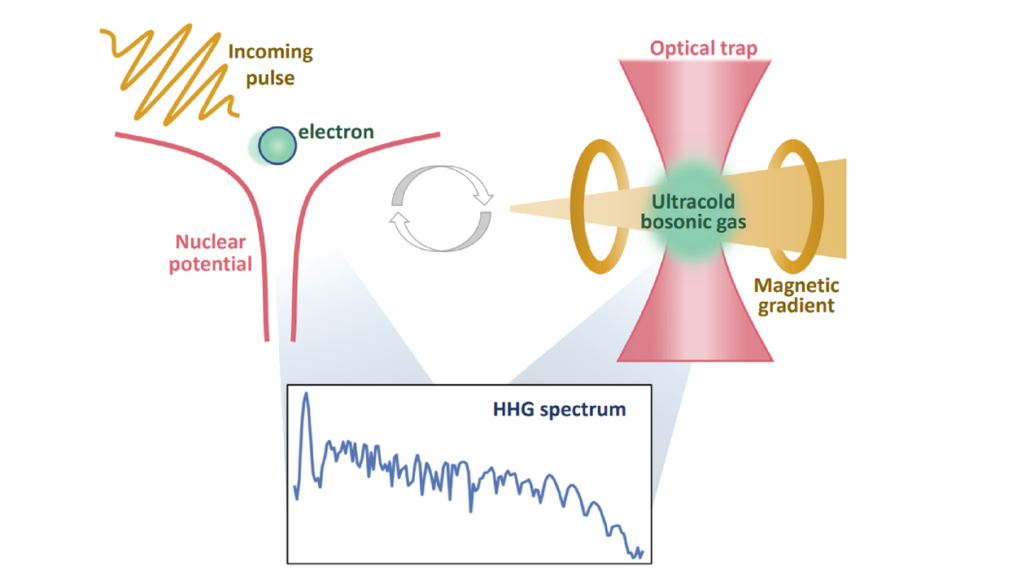New analog simulators can facilitate the study of ultrafast dynamics processes
A team of researchers, including DYNAMITE project team members, has theoretically proposed a new experimental platform based on analog simulation with atom clouds to study high-harmonic generation, an ultrafast dynamic process whose study challenges conventional computational methods. Their simulator can be adapted to approach a wide range of complex phenomena, opening the door to regimes that theory and direct experimentation are struggling to reach.
Despite all the successes in understanding electron dynamics at their natural attosecond (one quintillion of a second) time scale, one of the fundamental processes core to this field, high-harmonic generation (HHG), raises new challenges for cold-atom simulation. It consists in a highly non-linear phenomenon where a system absorbs many photons of an incoming laser and emits a single photon of much higher energy.
The unique characteristics of HHG make it an exceptional source of extreme ultraviolet radiation and consequently of attosecond pulses of light, which has important applications to various fields such as nonlinear optics or attosecond science.

Ultracold Atoms Mimic High-Harmonic Generation
The main obstacle hindering the study of this process, apart from the ultrafast speed at which it occurs, is the high number of variables involved. In any given material, many atoms and electrons are present, so to study most of the occurring chemical processes in all its complexity would require not only to describe all these components, but also their interactions with external fields and even among themselves. This turns out to be an extremely challenging task for any current classical computer. An alternative route is to use quantum devices, building the so-called analog simulators, whose nature allow them to better capture the complexity of the system.
Now, ICFO researchers Javier Argüello, Javier Rivera, Philipp Stammer led by the ICREA Prof. at ICFO Maciej Lewenstein, DYNAMITE coordinator, and in collaboration with other institutes all over the globe (Aarhus University, University of California and Guangdong Technion-Israel Institute of Technology) have proposed, in a Physical Review X Quantum publication, an analog simulator to access the emission spectrum of HHG using ultracold atomic clouds. Besides showing that an accurate replication of the key characteristics of the HHG processes in atoms was possible, they also provide details on how to implement it to specific atomic targets and discuss the main sources of errors.
The potential of analog simulation
An analog simulator allows scientists to study a complex quantum system, which poses computational challenges, by controlling and manipulating a much simpler system accessible through experimentation. However, not every choice is valid; a connection between the two systems must exist.
In this particular work, the researchers chose high-harmonic generation as the complex phenomenon to benchmark their idea. In this process, the atomic bound electrons tunnel out through the barrier formed by the atomic Coulomb potential and a laser electric field. Then, the acceleration of these free electrons causes the emission of radiation at characteristic harmonic frequencies upon recombination with their parent ions. The researchers aimed to recover this emission spectrum of the HHG.
The researchers established the connection to a much simpler quantum system by replacing specific components. They proposed to use an atomic gas trapped by a laser beam instead of an electron and a nuclear potential. They also suggested an external, tunable magnetic gradient instead of the incoming light and its electric field. It turns out that the absorption images of this engineered system match the desired emission yield.
Therefore, researchers can indirectly study the emission spectrum of atomic high-harmonic generation by taking absorption images of the analog simulator.
A new platform for ultrafast simulation
www.icfo.eu/news/2296/new-analog-simulators-can-facilitate-the-study-of-ultrafast-dynamics-processes/856
Ultimately, the research group has paved the way to demonstrate the potential of their alternative method for addressing complex systems that otherwise could only undergo theoretical approximations. They showed that state-of-the-art analog simulators can retrieve the HHG emission spectrum, and they established a correspondence between the experimental and simulated parameters. They also provided an exhaustive experimental analysis.
Furthermore, the platform offers twofold advantages. Firstly, researchers can easily tune the elements that emulate the incoming field and the nuclear potential. Secondly, the simulation provides temporal magnification. This implies a high level of accessibility, as researchers can avoid the attosecond time-scale, allowing them to work in a much slower (and thus more practical) frame.
The team emphasizes the adaptability of their approach, which is not limited to simulating HHG exclusively but could extend to other, more exotic configurations. In particular, the simulation of ultrafast processes, such as multielectronic dynamics or the reaction of matter to non-classical light, could benefit the most.
Original Article
Argüello-Luengo, J., Rivera-Dean, J., Stammer, P., Maxwell, A. S., Weld, D. M., Ciappina, M. F., & Lewenstein, M. (2024). Analog Simulation of High-Harmonic Generation in Atoms. PRX Quantum, 5(1), 10328. https://doi.org/10.1103/PRXQuantum.5.010328

 This project was funded within the QuantERA II Programme that has received funding from the European Union’s Horizon 2020 research and innovation programme under Grant Agreement No 101017733
This project was funded within the QuantERA II Programme that has received funding from the European Union’s Horizon 2020 research and innovation programme under Grant Agreement No 101017733
